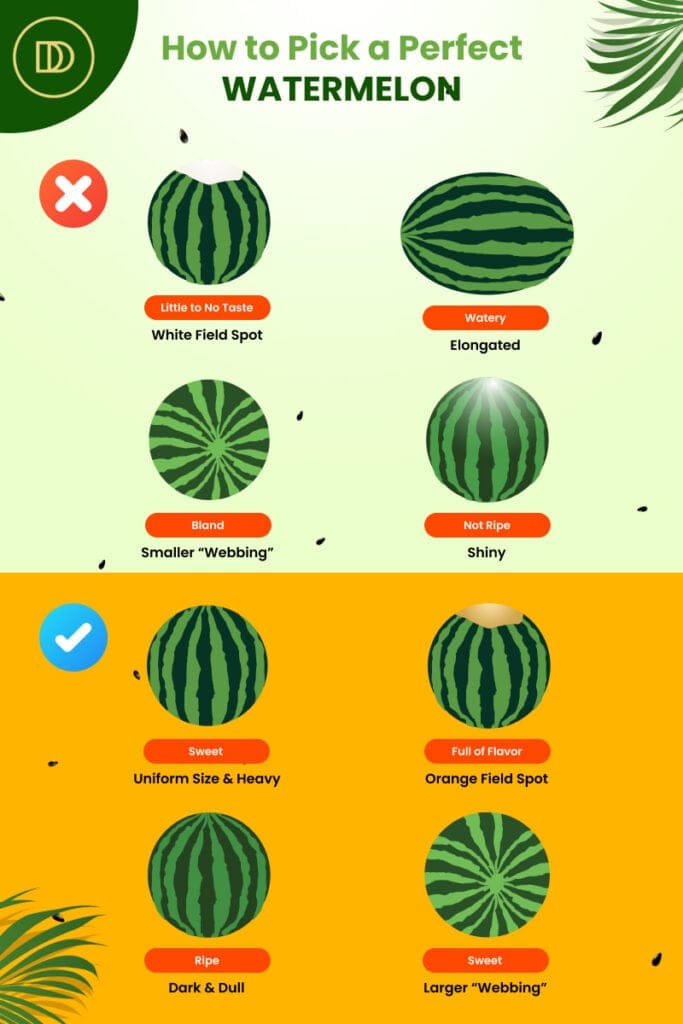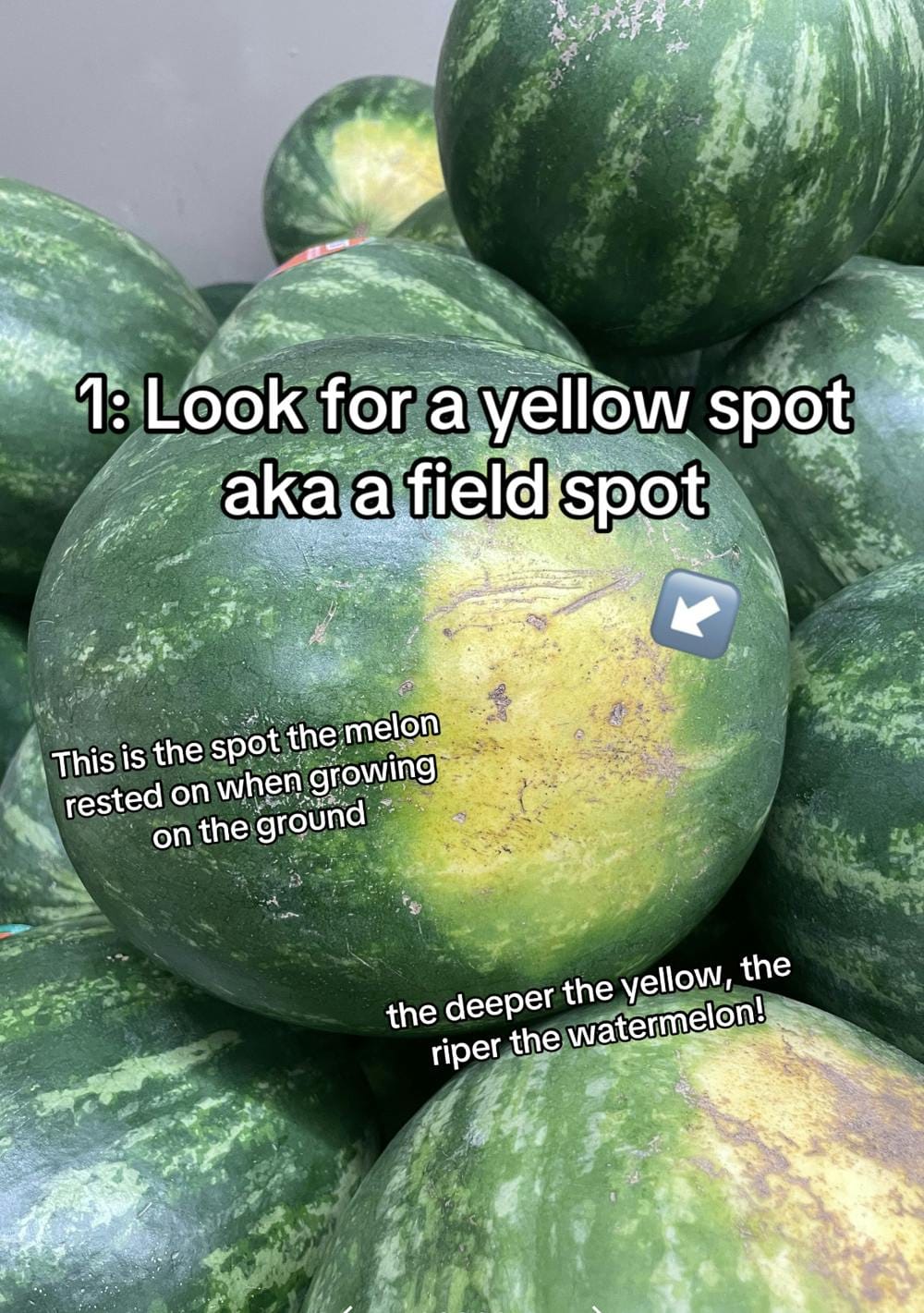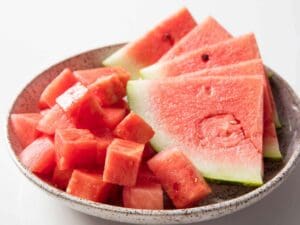Understanding Watermelon Varieties 🍉
Watermelons are known for their refreshingly sweet flavor and high water content, making them a perfect summer fruit. Most of their weight comes from their juice, which is why they feel so heavy. The two main types you’ll find in stores are seedless and seeded watermelons, with mini (personal-sized) watermelons also becoming popular for smaller households.
What to Look For 🔍
- Shape: Look for a symmetrical watermelon free of dents or irregularities.
- Color: The rind should be dull (not shiny) and have a consistent green color.
- Field Spot (Ground Spot): Look for a creamy yellow or orange spot on one side of the watermelon. This spot, also called the field spot or ground spot, shows where the watermelon rested on the ground while ripening. A well-ripened watermelon will have a prominent, creamy-colored spot.
- Weight: A ripe watermelon will feel heavy for its size, indicating high water content.
- Sound: Give it a tap—ripe watermelons produce a deep, hollow sound, which indicates juiciness. An underripe watermelon will sound dull or flat (less juicy), while an overripe one may sound too hollow or empty (overly soft).
- Seedless Option: Seedless watermelons make eating easier and less of a chore, perfect for quick snacking or serving at gatherings. While watermelon seeds are nutritious, they can be hard, and many people don’t like the contrast between the hard seeds and the soft flesh.


What to Avoid 🚫
- Watermelons with cuts, bruises, or soft spots.
- A shiny rind (this indicates underripeness).
- A lightweight watermelon (it may be dry inside).
- A white or pale green field spot (this suggests the watermelon was picked too early and didn’t fully ripen on the vine).
Storage Tips
- Store whole watermelons at room temperature if eating within a few days.
- For longer storage (space permitting): You can refrigerate a whole watermelon to keep it fresh for 1–2 weeks.
- Once cut: Slice the watermelon into halves, quarters, or even bite-sized pieces and place them in a bowl. Cover with plastic wrap or store in an airtight container in the fridge for 3–4 days.
How to Cut a Watermelon
- Wash the rind: Rinse the watermelon under cold water to clean the surface.
- Cut in half: Place the watermelon on a cutting board and slice it in half lengthwise.
- Quarter it: Cut each half into quarters for easier handling.
- Slice or cube: Remove the rind and slice the flesh into wedges or cut it into bite-sized cubes.

How They’re Sold 🛒
- Typically sold at a fixed price per unit.
- Sometimes pre-cut into halves, quarters, slices, or bite-sized pieces for convenience.
- Seasonality: Watermelons are most abundant and affordable during the summer months in most countries, making them a seasonal treat. However, they are still available year-round, though prices may be higher outside of peak season.
Why Watermelons? 🌟
- Hydrating and low in calories, making them perfect for summer.
- Packed with vitamins A and C, as well as antioxidants like lycopene.
- Refreshing and versatile—great for snacking, juicing, or adding to salads.
Ways to Use a Watermelon 🍽️
- Eating Fresh: Slice the watermelon into wedges or cubes for easy snacking.
- Juicing: Blend watermelon chunks to make fresh juice or smoothies.
- Salads: Add cubed watermelon to salads with feta cheese, mint, and a drizzle of balsamic glaze.
- Desserts: Use watermelon as a base for sorbets, popsicles, or fruit salads.
Fun Fact: Suikawari (Watermelon Splitting)
In Japan, there’s a traditional summer game called Suikawari (スイカ割り), which translates to “watermelon splitting.” It’s a popular activity at beaches, festivals, and summer gatherings. Here’s how it works:
- A watermelon is placed on the ground, often on a tarp or mat.
- One person is blindfolded and given a stick or bat.
- They’re spun around a few times to disorient them.
- Other participants shout directions (like “left,” “right,” “forward”) to guide the blindfolded person toward the watermelon.
- The blindfolded person swings the stick to try and crack the watermelon open.
- Once the watermelon is split, everyone shares and eats it together.
This fun and lighthearted game is a great way to enjoy watermelons during the summer while spending time with friends and/or family!
